headlights TOYOTA FR-S 2013 Owners Manual (in English)
[x] Cancel search | Manufacturer: TOYOTA, Model Year: 2013, Model line: FR-S, Model: TOYOTA FR-S 2013Pages: 448, PDF Size: 5.59 MB
Page 6 of 448
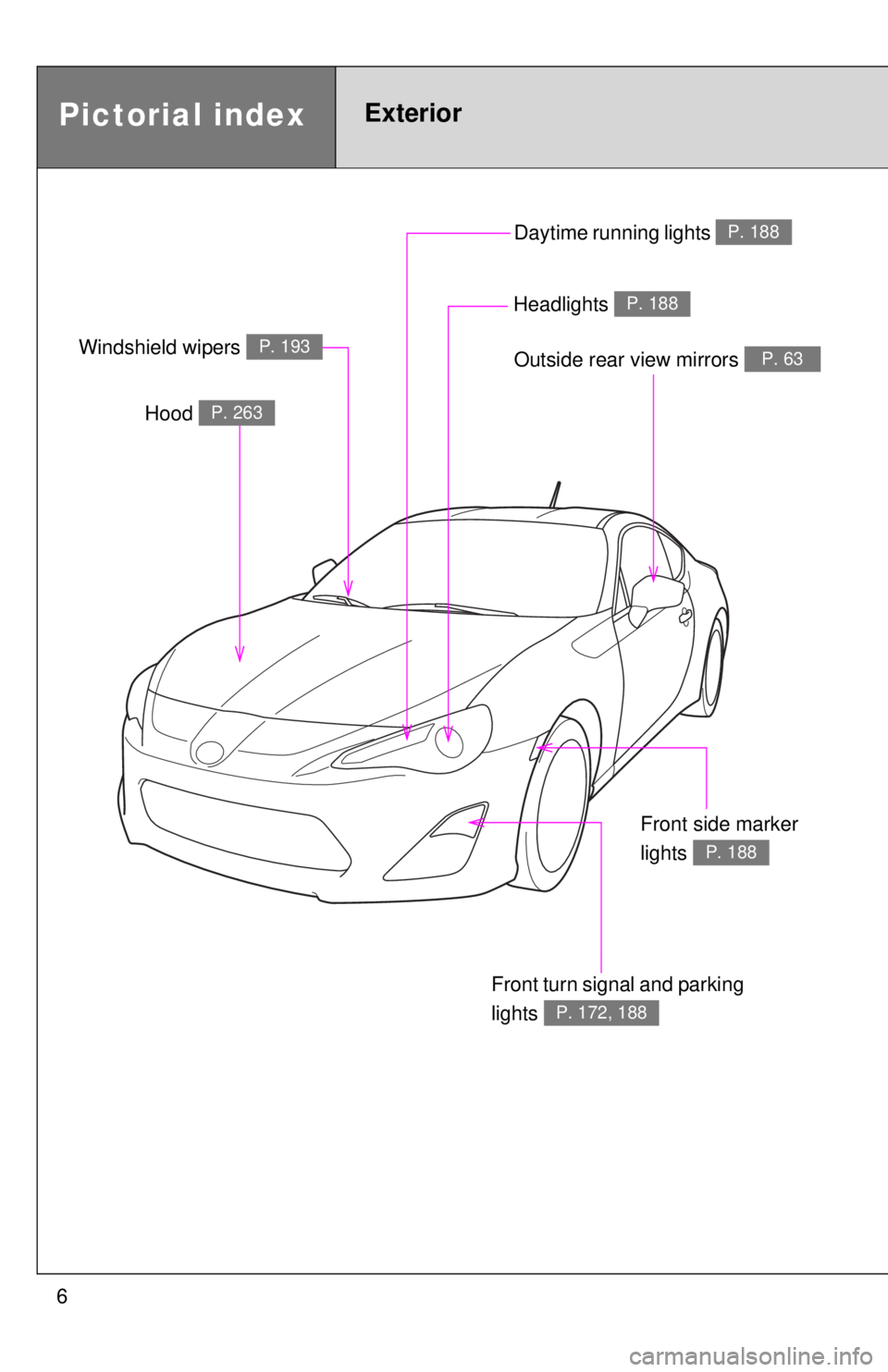
6Daytime running lights
P. 188
Pictorial indexExterior
Outside rear view mirrors P. 63
Front turn signal and parking
lights
P. 172, 188
Hood P. 263
Windshield wipers P. 193
Headlights P. 188
Front side marker
lights
P. 188
Page 62 of 448
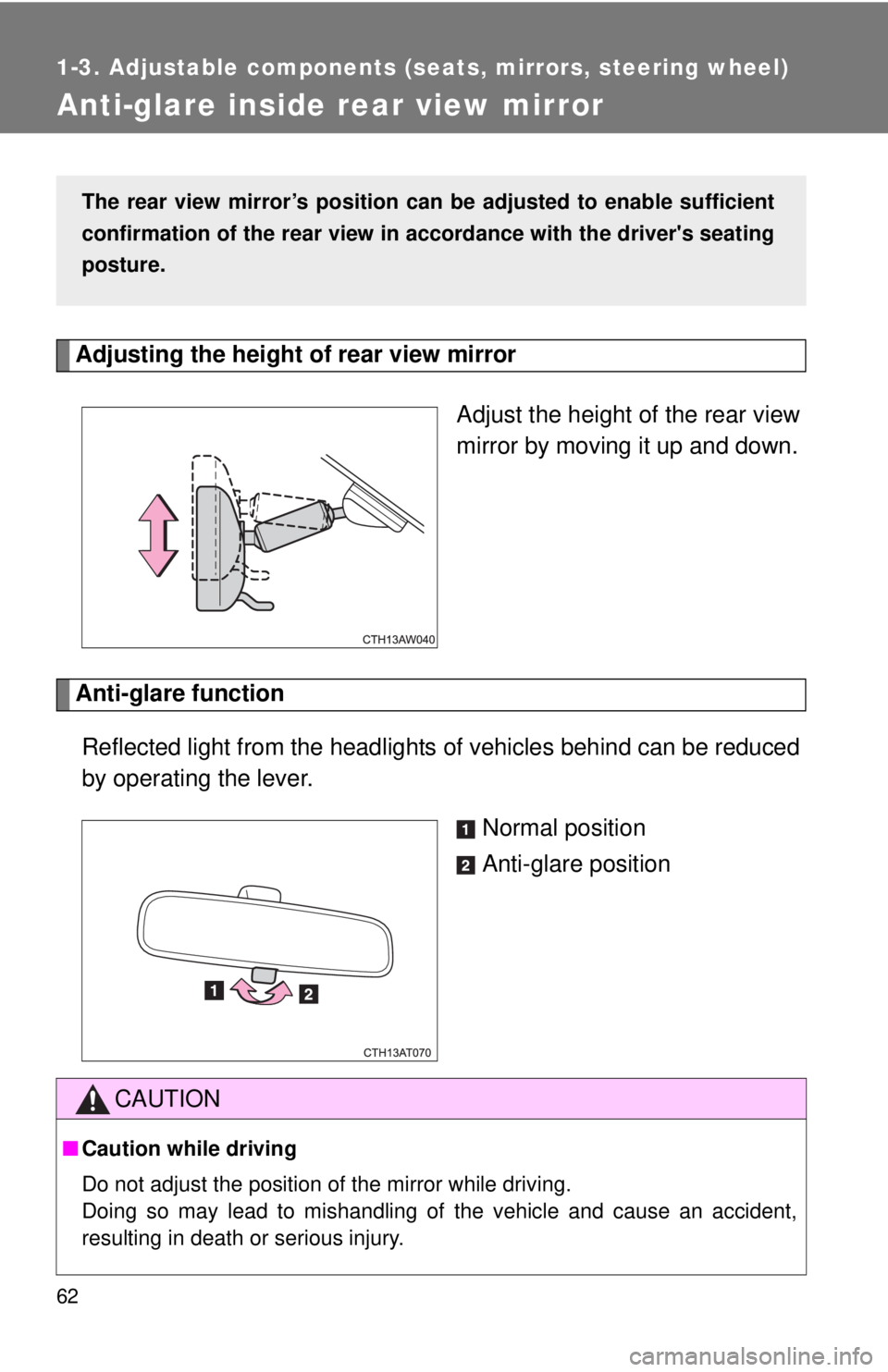
62
1-3. Adjustable components (seats, mirrors, steering wheel)
Anti-glare inside rear view mirror
Adjusting the height of rear view mirror Adjust the height of the rear view
mirror by moving it up and down.
Anti-glare functionReflected light from the headlights of vehicles behind can be reduced
by operating the lever.
Normal position
Anti-glare position
The rear view mirror’s position can be adjusted to enable sufficient
confirmation of the rear view in accordance with the driver's seating
posture.
CAUTION
■ Caution while driving
Do not adjust the position of the mirror while driving.
Doing so may lead to mishandling of the vehicle and cause an accident,
resulting in death or serious injury.
Page 177 of 448
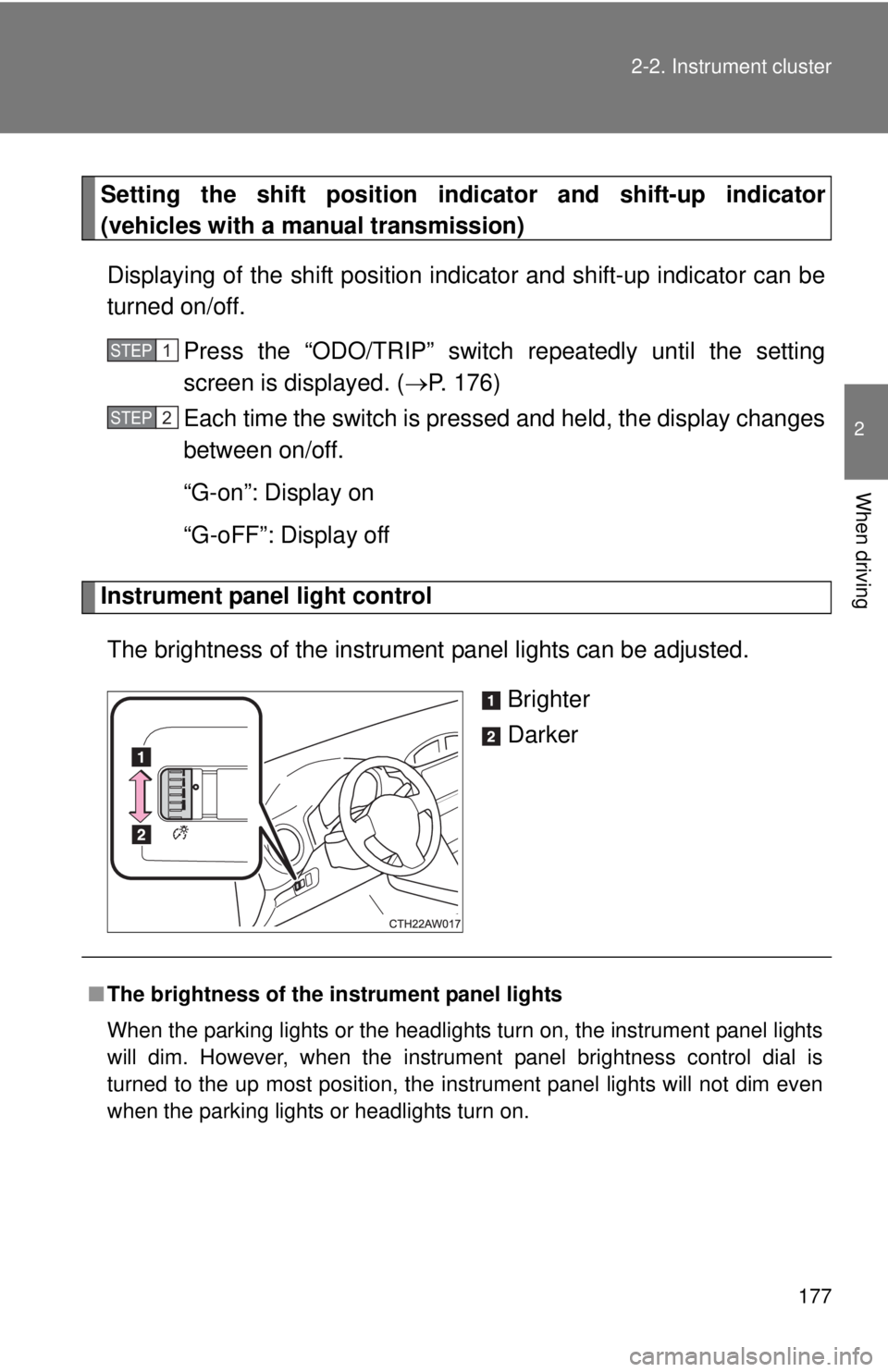
177
2-2. Instrument cluster
2
When driving
Setting the shift position indicator and shift-up indicator
(vehicles with a manual transmission)
Displaying of the shift position i ndicator and shift-up indicator can be
turned on/off.
Press the “ODO/TRIP” switch repeatedly until the setting
screen is displayed. ( P. 176)
Each time the switch is pressed and held, the display changes
between on/off.
“G-on”: Display on
“G-oFF”: Display off
Instrument panel light control
The brightness of the instrument panel lights can be adjusted.
Brighter
Darker
STEP 1
STEP 2
■The brightness of the instrument panel lights
When the parking lights or the headlights turn on, the instrument panel lights
will dim. However, when the instrument panel brightness control dial is
turned to the up most position, the instrument panel lights will not dim even
when the parking lights or headlights turn on.
Page 188 of 448
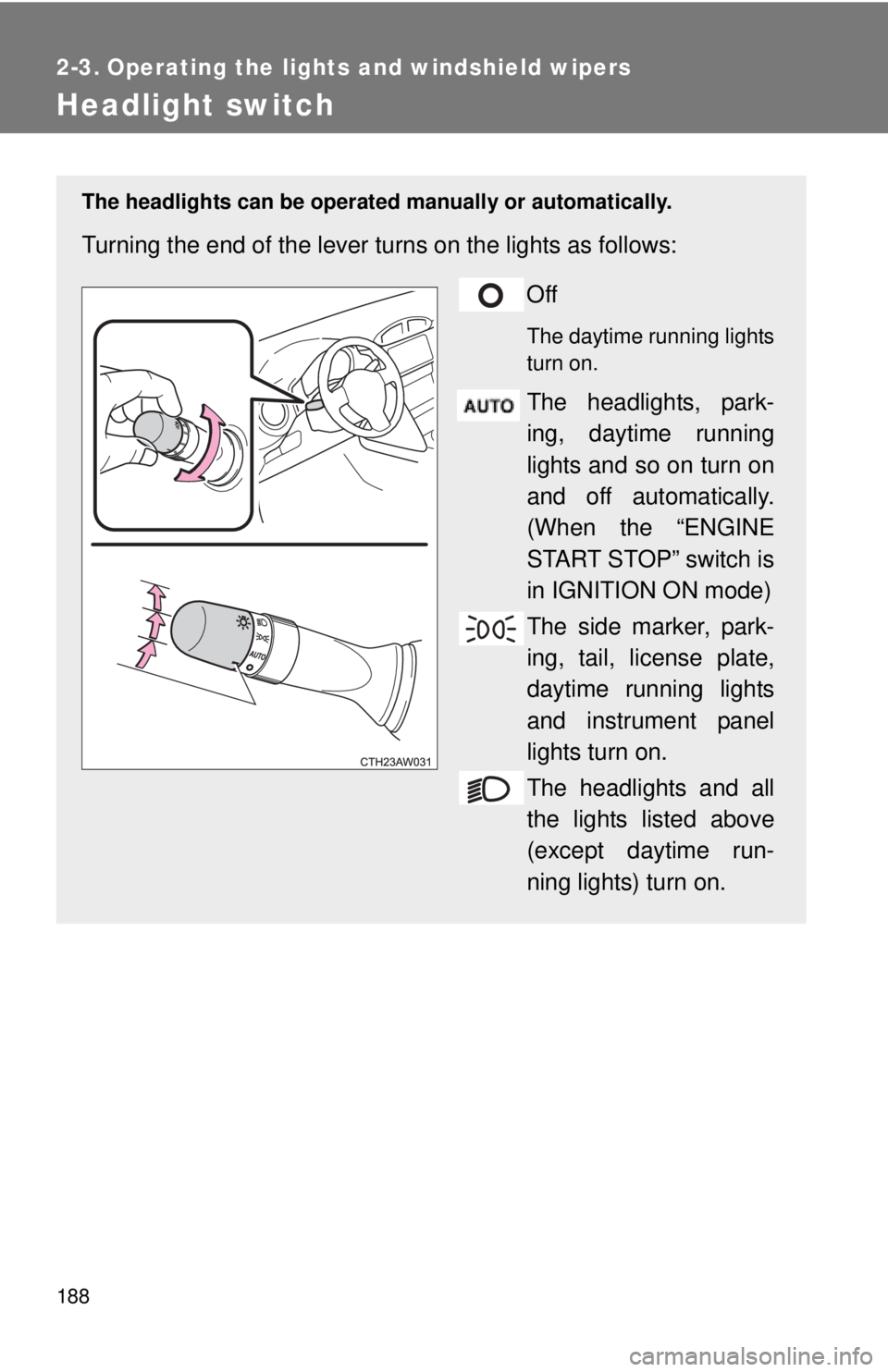
188
2-3. Operating the lights and windshield wipers
Headlight switch
The headlights can be operated manually or automatically.
Turning the end of the lever turns on the lights as follows:
Off
The daytime running lights
turn on.
The headlights, park-
ing, daytime running
lights and so on turn on
and off automatically.
(When the “ENGINE
START STOP” switch is
in IGNITION ON mode)
The side marker, park-
ing, tail, license plate,
daytime running lights
and instrument panel
lights turn on.
The headlights and all
the lights listed above
(except daytime run-
ning lights) turn on.
Page 189 of 448
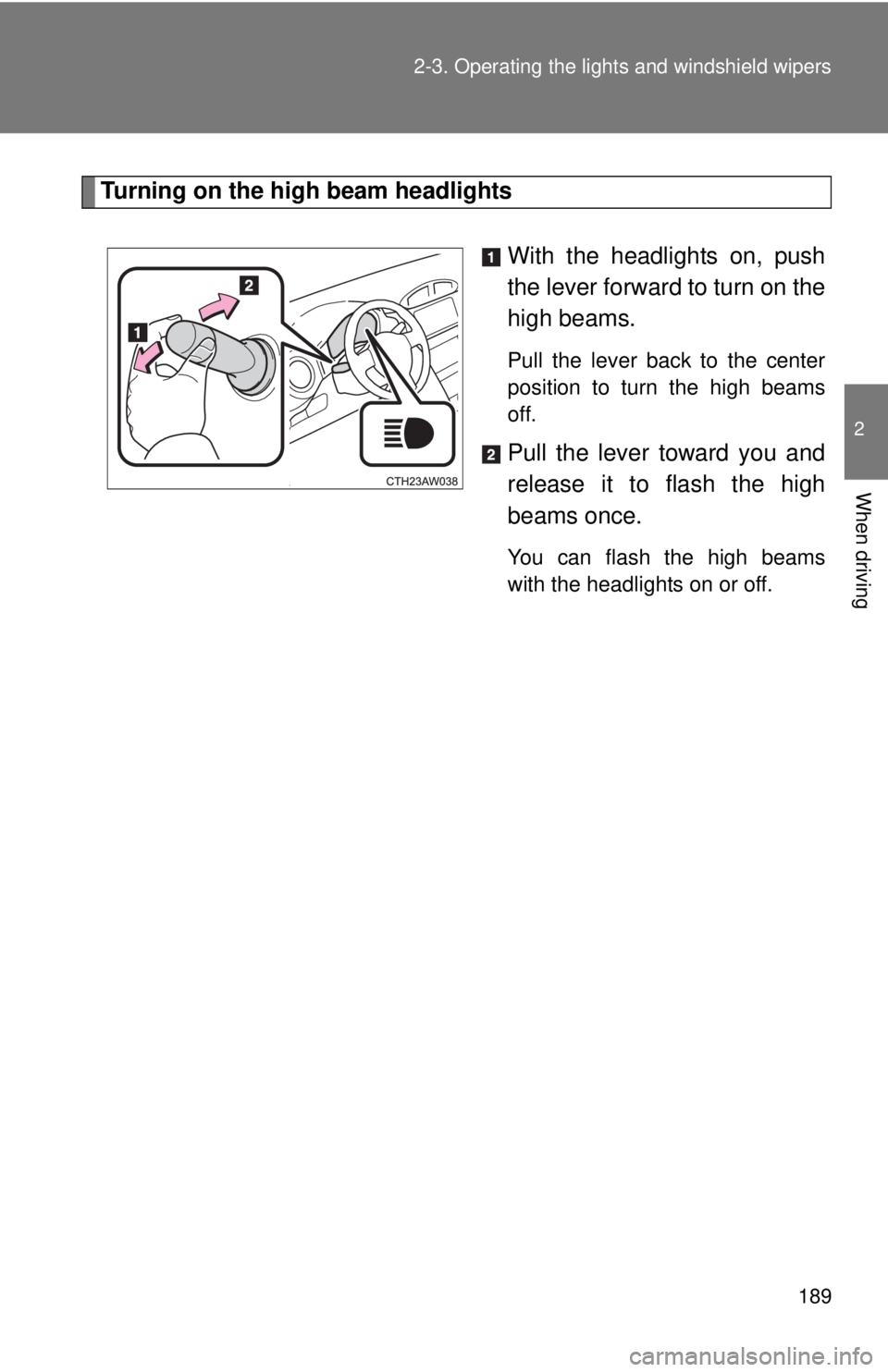
189
2-3. Operating the lights and windshield wipers
2
When driving
Turning on the high beam headlights
With the headlights on, push
the lever forward to turn on the
high beams.
Pull the lever back to the center
position to turn the high beams
off.
Pull the lever toward you and
release it to flash the high
beams once.
You can flash the high beams
with the headlights on or off.
Page 190 of 448
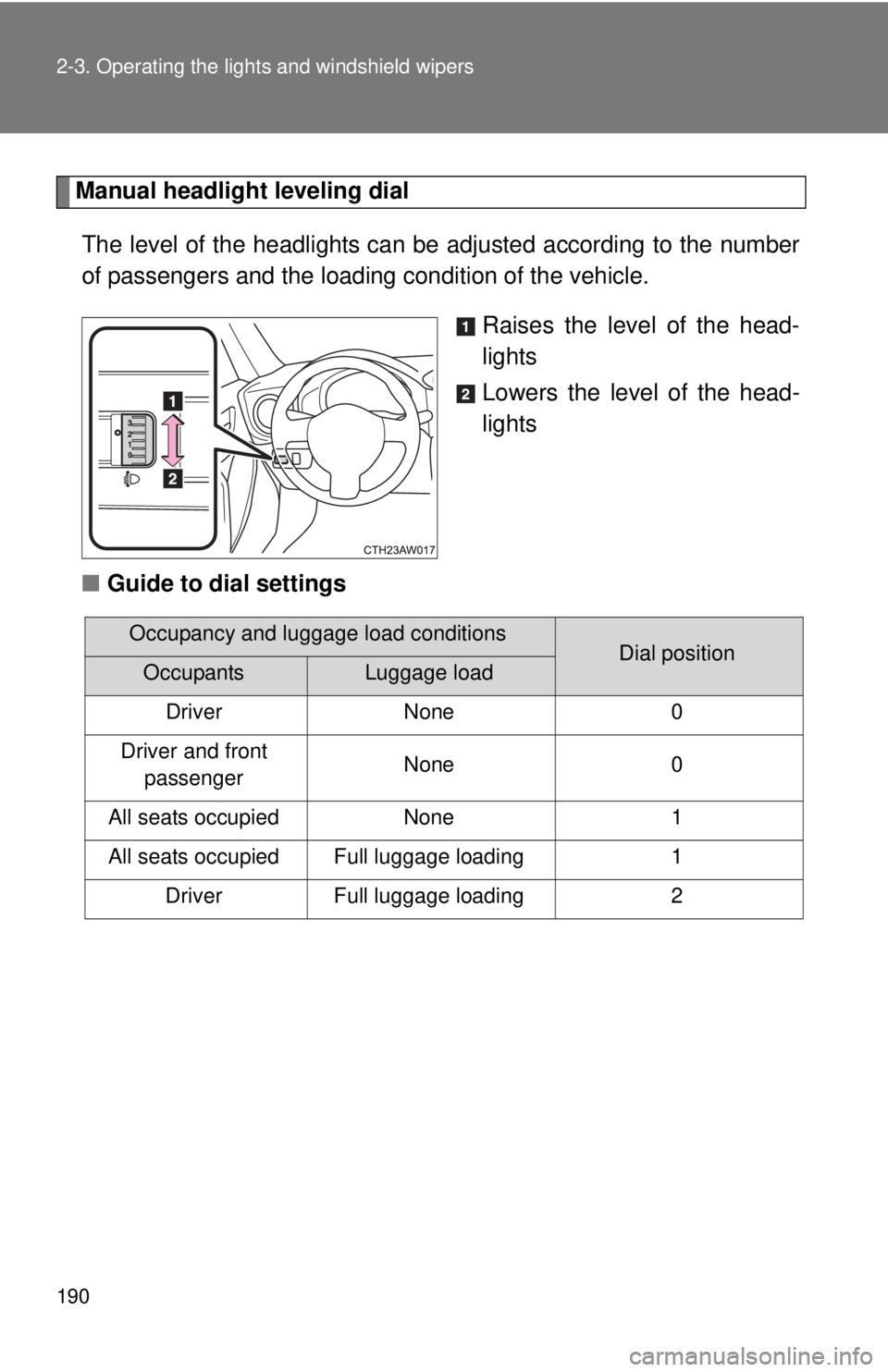
190 2-3. Operating the lights and windshield wipers
Manual headlight leveling dial
The level of the headlights can be adjusted according to the number
of passengers and the loading condition of the vehicle.
Raises the level of the head-
lights
Lowers the level of the head-
lights
■ Guide to dial settings
Occupancy and luggage load conditionsDial positionOccupantsLuggage load
Driver None 0
Driver and front passenger None 0
All seats occupied None 1
All seats occupied Full luggage loading 1 Driver Full luggage loading 2
Page 191 of 448
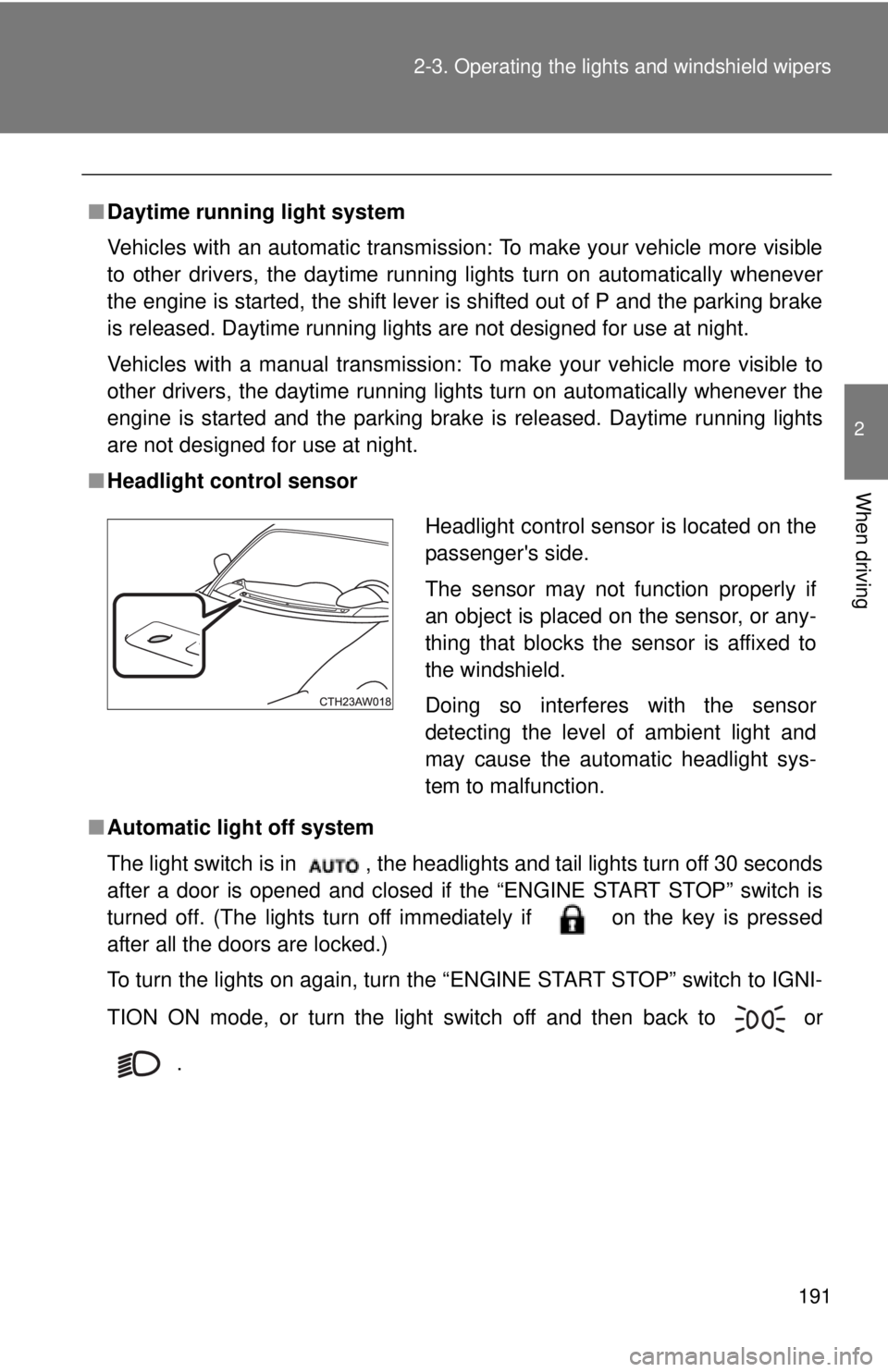
191
2-3. Operating the lights and windshield wipers
2
When driving
■
Daytime running light system
Vehicles with an automatic transmission: To make your vehicle more visible
to other drivers, the daytime running lights turn on automatically whenever
the engine is started, the shift lever is shifted out of P and the parking brake
is released. Daytime running lights are not designed for use at night.
Vehicles with a manual transmission: To make your vehicle more visible to
other drivers, the daytime running light s turn on automatically whenever the
engine is started and the parking brake is released. Daytime running lights
are not designed for use at night.
■ Headlight control sensor
■ Automatic light off system
The light switch is in , the headlights and tail lights turn off 30 seconds
after a door is opened and closed if the “ENGINE START STOP” switch is
turned off. (The lights turn off immediately if on the key is pressed
after all the doors are locked.)
To turn the lights on again, turn the “ENGINE START STOP” switch to IGNI-
TION ON mode, or turn the light switch off and then back to
or
.
Headlight control sensor is located on the
passenger's side.
The sensor may not function properly if
an object is placed on the sensor, or any-
thing that blocks the sensor is affixed to
the windshield.
Doing so interferes with the sensor
detecting the level of ambient light and
may cause the automatic headlight sys-
tem to malfunction.
Page 192 of 448
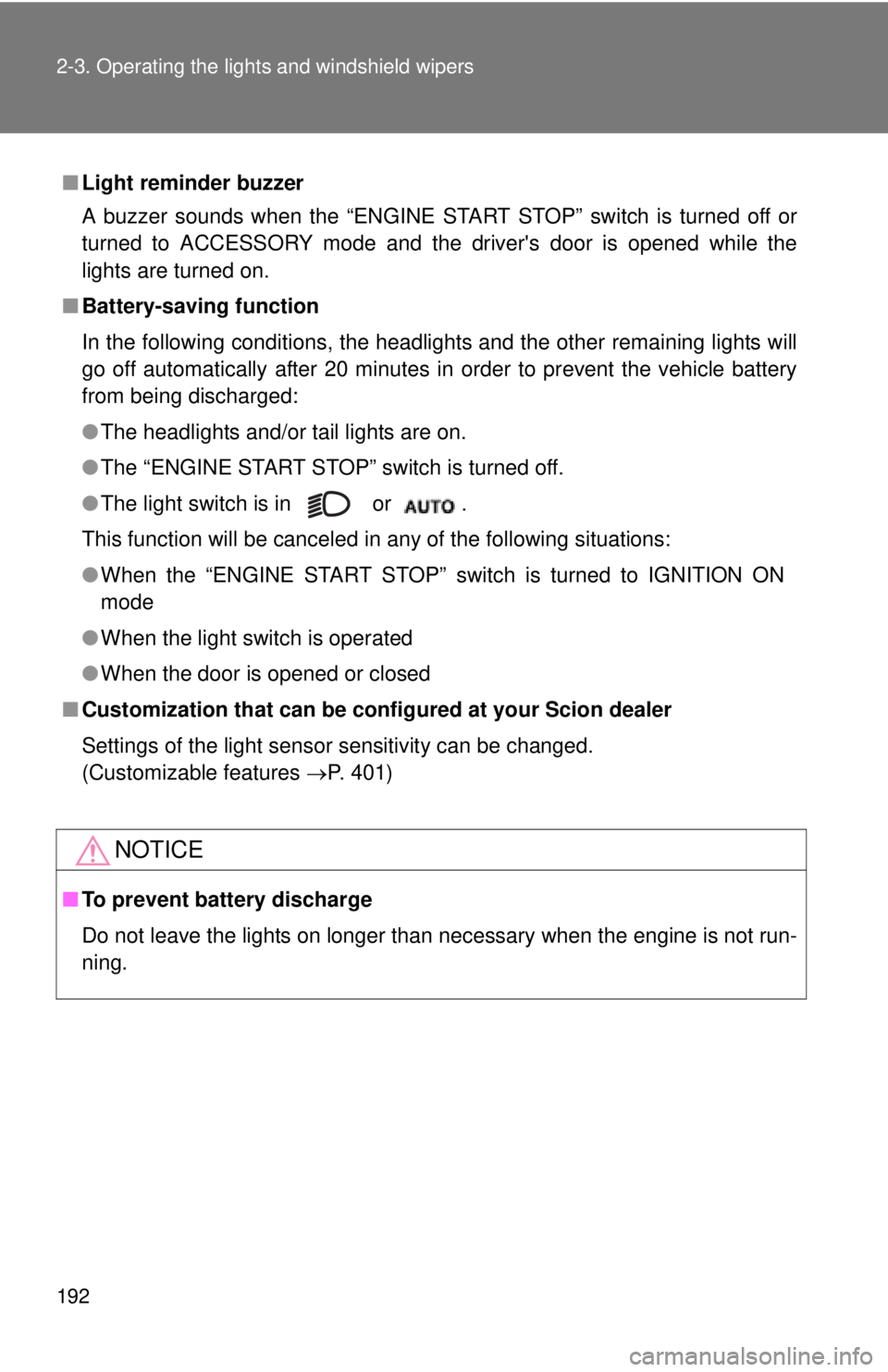
192 2-3. Operating the lights and windshield wipers
■Light reminder buzzer
A buzzer sounds when the “ENGINE START STOP” switch is turned off or
turned to ACCESSORY mode and the driver's door is opened while the
lights are turned on.
■ Battery-saving function
In the following conditions, the headlights and the other remaining lights will
go off automatically after 20 minutes in order to prevent the vehicle battery
from being discharged:
●The headlights and/or tail lights are on.
● The “ENGINE START STOP” switch is turned off.
● The light switch is in or .
This function will be canceled in any of the following situations:
● When the “ENGINE START STOP” switch is turned to IGNITION ON
mode
● When the light switch is operated
● When the door is opened or closed
■ Customization that can be conf igured at your Scion dealer
Settings of the light sensor sensitivity can be changed.
(Customizable features P. 401)
NOTICE
■To prevent battery discharge
Do not leave the lights on longer than necessary when the engine is not run-
ning.
Page 314 of 448
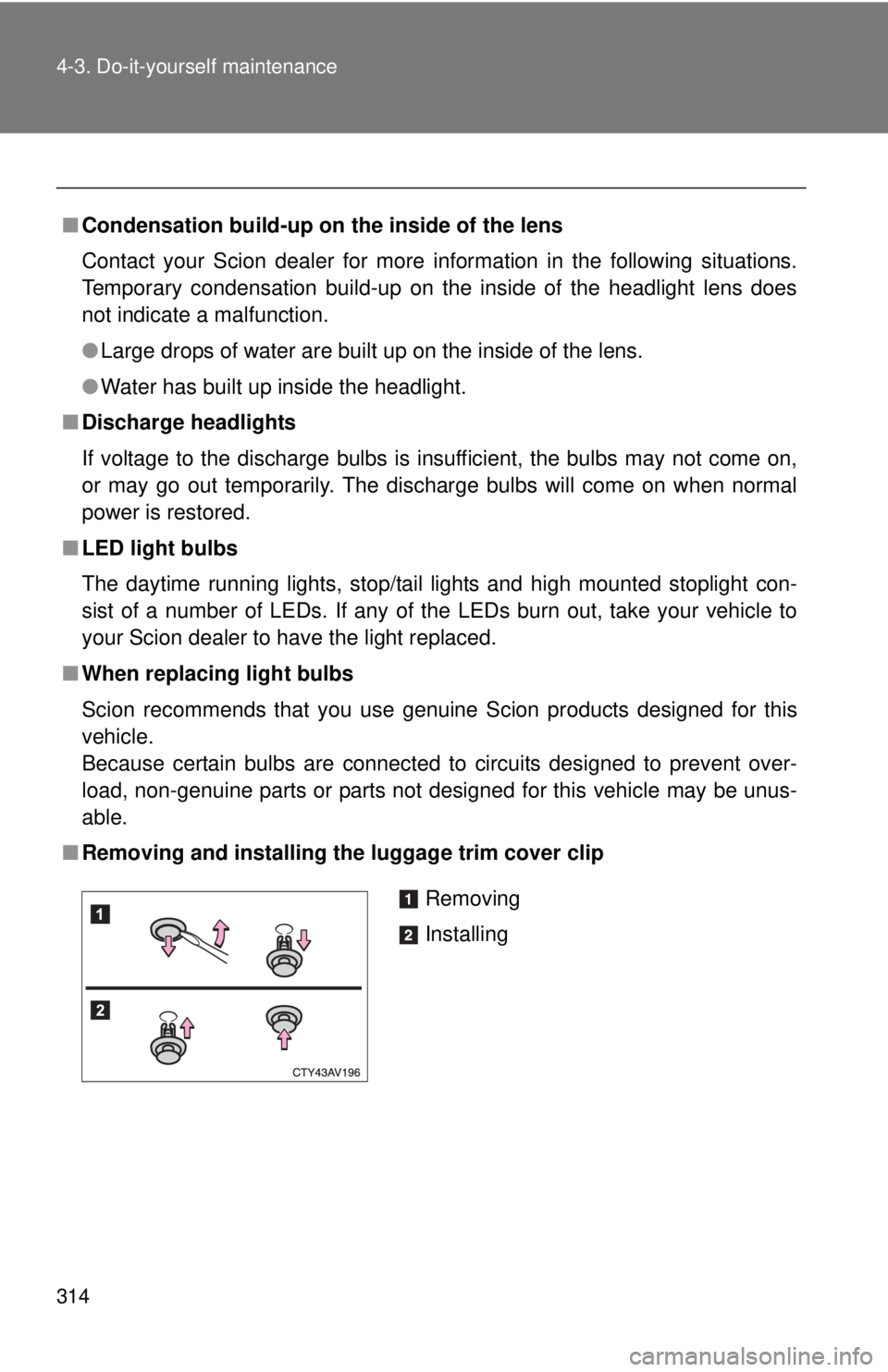
314 4-3. Do-it-yourself maintenance
■Condensation build-up on th e inside of the lens
Contact your Scion dealer for more information in the following situations.
Temporary condensation build-up on the inside of the headlight lens does
not indicate a malfunction.
● Large drops of water are built up on the inside of the lens.
● Water has built up inside the headlight.
■ Discharge headlights
If voltage to the discharge bulbs is insufficient, the bulbs may not come on,
or may go out temporarily. The discharge bulbs will come on when normal
power is restored.
■ LED light bulbs
The daytime running lights, stop/tail lights and high mounted stoplight con-
sist of a number of LEDs. If any of the LEDs burn out, take your vehicle to
your Scion dealer to have the light replaced.
■ When replacing light bulbs
Scion recommends that you use genuine Scion products designed for this
vehicle.
Because certain bulbs are connected to circuits designed to prevent over-
load, non-genuine parts or parts not designed for this vehicle may be unus-
able.
■ Removing and installing the luggage trim cover clip
Removing
Installing
Page 315 of 448
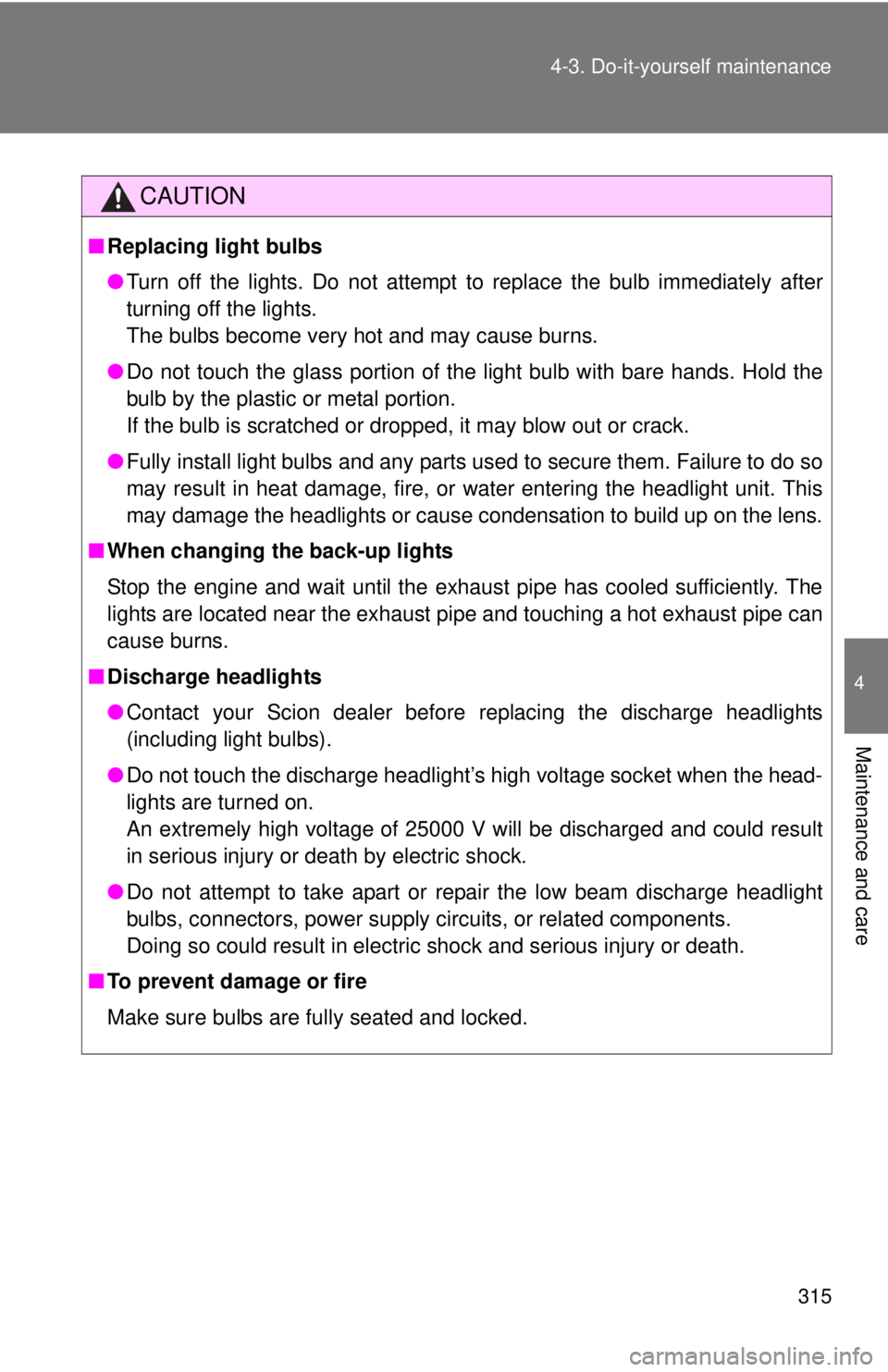
315
4-3. Do-it-yourself maintenance
4
Maintenance and care
CAUTION
■
Replacing light bulbs
●Turn off the lights. Do not attempt to replace the bulb immediately after
turning off the lights.
The bulbs become very hot and may cause burns.
● Do not touch the glass portion of the light bulb with bare hands. Hold the
bulb by the plastic or metal portion.
If the bulb is scratched or dropped, it may blow out or crack.
● Fully install light bulbs and any parts used to secure them. Failure to do so
may result in heat damage, fire, or water entering the headlight unit. This
may damage the headlights or cause condensation to build up on the lens.
■ When changing the back-up lights
Stop the engine and wait until the exhaust pipe has cooled sufficiently. The
lights are located near the exhaust pipe and touching a hot exhaust pipe can
cause burns.
■ Discharge headlights
●Contact your Scion dealer before replacing the discharge headlights
(including light bulbs).
● Do not touch the discharge headlight’s high voltage socket when the head-
lights are turned on.
An extremely high voltage of 25000 V will be discharged and could result
in serious injury or death by electric shock.
● Do not attempt to take apart or repair the low beam discharge headlight
bulbs, connectors, power supply circuits, or related components.
Doing so could result in electric shock and serious injury or death.
■ To prevent damage or fire
Make sure bulbs are fully seated and locked.